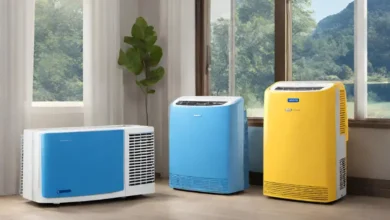Exploring Eco-Friendly Air Conditioner Alternatives: A Sustainable Approach to Cooling in India

In the midst of India’s sweltering summers, where the need for effective cooling is undeniable, the environmental impact of traditional air conditioners cannot be overlooked. As energy resources become more precious and climate concerns intensify, the quest for eco-friendly alternatives has gained unprecedented significance.
Also read: Best AC in India 2024
This blog delves into the realm of sustainable cooling solutions tailored for the unique climate and energy considerations of India. From the challenges posed by traditional air conditioners to the rise of energy-efficient models, solar-powered innovations, and nature-inspired alternatives, we embark on a journey to discover a cooler and greener tomorrow.
Join us as we navigate through a landscape of eco-friendly air conditioning options, exploring technologies that balance comfort and conservation. From harnessing the power of the sun to tapping into the Earth’s natural energy, the possibilities are diverse. As technology evolves and environmental consciousness deepens, this exploration promises a future where cooling is not just a comfort but a responsible and sustainable practice.
In a nation with a vast and diverse consumer base, where the choices of individuals can drive manufacturers to innovate, the responsibility lies not only with the industry but also with consumers. By embracing eco-friendly alternatives, India has the potential to pave the way for a future where cooling aligns seamlessly with environmental responsibility. Let’s embark on this journey toward a cooler, greener, and more sustainable tomorrow.
1. Understanding the Environmental Impact of Traditional Air Conditioners
Traditional air conditioners have long been a mainstay in Indian households, providing much-needed relief from the scorching heat. However, their environmental impact cannot be ignored. In India, where energy resources are precious and climate concerns are pressing, the need for eco-friendly alternatives is more significant than ever.
The environmental concerns associated with traditional air conditioners are two-fold. Firstly, the refrigerants used in these systems contribute to greenhouse gas emissions, further exacerbating climate change. Secondly, the high energy consumption of these units puts strain on power grids, often reliant on non-renewable sources. As India grapples with energy security and strives for sustainability, it becomes crucial to explore alternatives that address these concerns.
2. The Rise of Energy-Efficient Air Conditioners
In response to the environmental challenges posed by traditional air conditioners, the adoption of energy-efficient systems is gaining traction in India. Energy-efficient models incorporate advanced technologies like variable-speed compressors and smart thermostats to optimize cooling while minimizing energy consumption.
These systems are designed to provide substantial energy savings, leading to reduced electricity bills—a crucial consideration for Indian consumers. While the upfront cost might be higher, the long-term benefits, both in terms of cost savings and environmental impact, make them a viable and responsible choice.
3. Solar-Powered Air Conditioning: Harnessing the Power of the Sun
Given India’s abundant sunlight, solar-powered air conditioning emerges as a promising eco-friendly alternative. Photovoltaic panels convert sunlight into electricity, reducing dependence on traditional power sources. Despite a relatively higher initial setup cost, the long-term advantages, including lower operational expenses and a reduced carbon footprint, make solar-powered AC units an attractive proposition.
In regions with ample sunlight, such as many parts of India, harnessing solar energy for air conditioning aligns with the nation’s commitment to renewable energy adoption.
4. Geothermal Cooling Systems: Tapping into Earth’s Natural Energy
India’s diverse geography provides an opportunity to explore geothermal cooling systems, a sustainable approach that taps into the Earth’s natural energy. These systems circulate fluid through underground pipes, leveraging the stable temperature below the surface to absorb heat from buildings and release it into the cooler ground.
Geothermal cooling is highly energy-efficient and has minimal environmental impact, making it well-suited for India’s climate. As the country seeks innovative solutions to balance comfort and conservation, geothermal cooling presents itself as a compelling option.
5. Evaporative Coolers: Nature-Inspired Cooling
In arid regions of India, where traditional air conditioners may pose challenges due to water scarcity and high energy demands, evaporative coolers offer a nature-inspired alternative. By utilizing the evaporation of water to cool the air, these systems consume significantly less electricity compared to their traditional counterparts.
For instance, in states like Rajasthan, where dry and hot conditions prevail, evaporative coolers become a sustainable choice, contributing to lower energy demands and reduced environmental impact.
6. Ice-Powered Air Conditioning: Chilling Innovation
Innovation takes center stage with ice-powered air conditioning, introducing a unique and eco-friendly twist to cooling technology. During off-peak hours when electricity demand is low, excess power is used to freeze water, creating ice. When cooling is required, the system circulates air over the ice, providing an energy-efficient and sustainable cooling solution.
This innovative approach aligns with India’s quest for technological solutions that balance comfort and environmental responsibility.
7. Smart Ventilation Systems: Balancing Fresh Air and Cooling
Smart ventilation systems contribute to sustainable cooling by integrating with natural ventilation. These systems automatically adjust airflow, optimizing indoor air quality while minimizing the need for continuous air conditioning. In a country like India, where indoor air quality is a growing concern, smart ventilation becomes a holistic approach to cooling and environmental well-being.
By incorporating outside air strategically when conditions allow, these systems contribute to a more sustainable and energy-efficient cooling strategy.
8. Plant-Based Air Purifiers: Greening Indoor Spaces
Beyond the cooling systems themselves, integrating plant-based air purifiers enhances the sustainability of indoor environments. Certain houseplants act as natural air purifiers, removing pollutants and enhancing overall air quality. This not only complements the eco-friendly cooling approach but also creates a harmonious and sustainable indoor atmosphere.
In the context of Indian homes, where indoor air pollution is a significant issue, adopting plant-based air purifiers aligns with the goal of creating healthier living spaces.
9. Energy-Efficient Construction and Insulation
Beyond specific air conditioning systems, the construction and insulation of buildings play a crucial role in achieving overall energy efficiency. Well-insulated structures, coupled with energy-efficient design principles, can significantly reduce the overall cooling demand.
For example, incorporating insulation techniques suitable for the Indian climate, such as cool roofs and insulated walls, contributes to a more sustainable and eco-friendly living environment. As the demand for cooling solutions continues to rise, optimizing the energy efficiency of buildings becomes an integral part of India’s sustainable development.
10. Consumer Awareness and Responsibility
The transition to eco-friendly air conditioning is not solely dependent on technological advancements but also on consumer awareness and responsibility. Informed choices, considering the environmental impact of products and practices, empower individuals to contribute to a greener future.
In India, where the consumer base is vast and diverse, creating awareness about the environmental implications of air conditioning choices becomes paramount. By making conscious decisions and demanding sustainable options, consumers play a pivotal role in driving manufacturers to innovate and produce more eco-friendly solutions.
Conclusion: A Cooler, Greener Tomorrow
As India navigates the challenges of a warming climate and increasing energy demands, the pursuit of eco-friendly air conditioning alternatives takes center stage. The landscape of sustainable cooling is expanding, offering a range of options that cater to the country’s unique climate and energy considerations.
From harnessing solar power and tapping into the Earth’s natural energy to innovative ice-powered solutions and the integration of plant-based air purifiers, the possibilities for a cooler and greener tomorrow are diverse. As technology evolves and environmental consciousness deepens, the journey towards sustainable cooling promises a future where comfort and conservation coexist seamlessly. The responsibility lies not only with manufacturers to innovate but also with consumers to make choices that contribute to a sustainable and environmentally conscious way of life. By embracing eco-friendly alternatives, India can pave the way for a future where cooling is not just a comfort but a responsible and sustainable practice.





